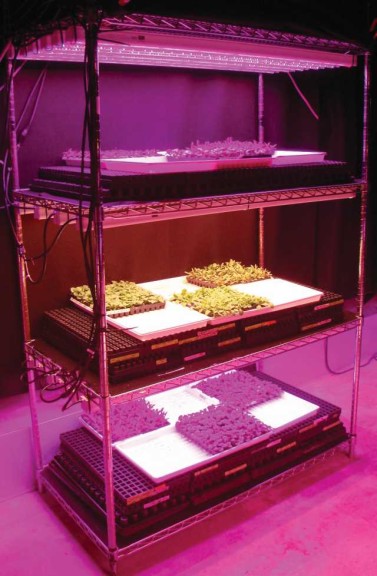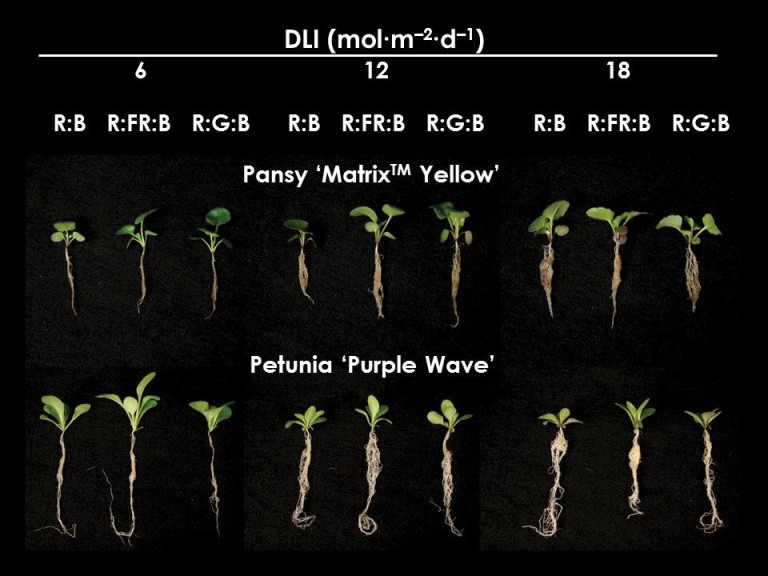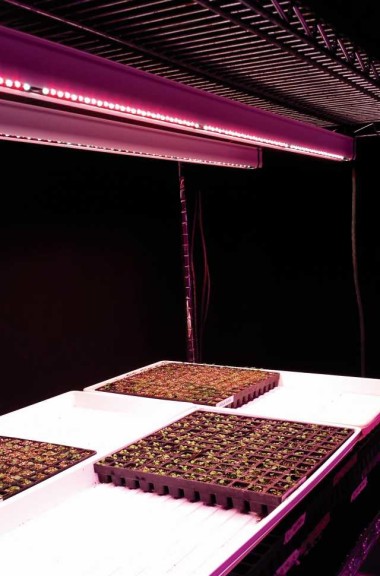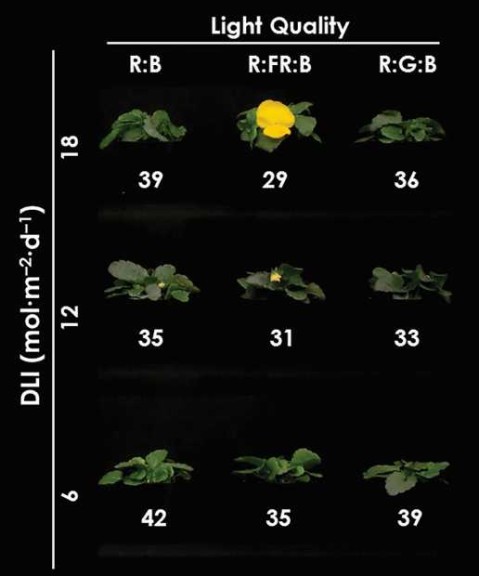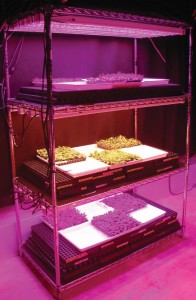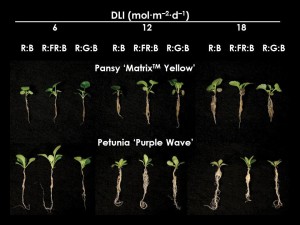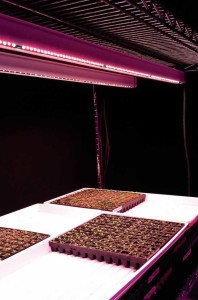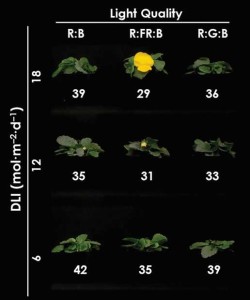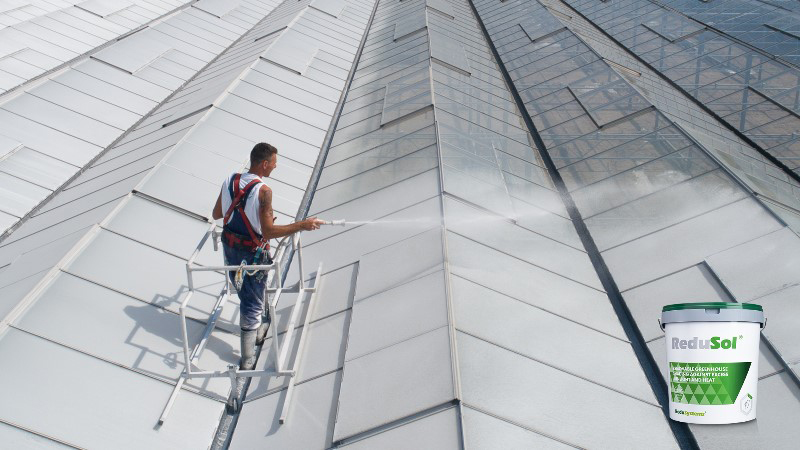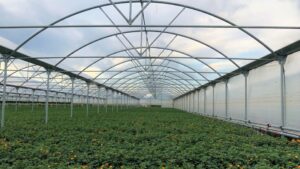Sole-Source Lighting In Horticulture: Bedding Plant Plug Production
Currently, indoor vertical production systems are focused primarily on the production of leafy green crops. However, additional horticulture crops with a short production cycle may also benefit from this type of system. In this final article of a four-part series highlighting the multiple uses of high-intensity, light-emitting diodes (LEDs), we will discuss how this lighting technology can be utilized in the production of bedding plant seedlings (plugs).
The production of bedding plant plugs commonly occurs during the winter and early spring. However, the daily light integral (DLI) in northern climates can be as low as 1 to 5 mol·m–2·d–1 during this time of the year. This low-average DLI can be an issue for plug production, as previous research has shown that a target DLI of 10 to 12 mol·m–2·d–1 is necessary to reduce production time and increase plug uniformity, consistency and quality.
Thus, to efficiently produce bedding plant plugs in the late winter and early spring in northern climates, some form of supplemental lighting (SL) must be administered. In an attempt to avoid some of these production issues and inconsistencies related to lighting with greenhouse production, one alternative may involve producing plugs under sole-source lighting (SSL) using LEDs.
Specifically, LEDs are solid-state semiconductor devices that are able to produce light with a very narrow spectrum. While we indicated many benefits of LED lighting in previous articles in the series, one of the most beneficial attributes LEDs possess is a low output of radiant heat. This characteristic is of particular value for growers looking at LEDs for use in SSL applications.
Since the waste heat from LEDs can be separated from the light that is emitted, multi-layered production in controlled environments is possible as plants can be grown very close to the LED arrays. Additionally, since specific wavelengths of light can be targeted using LEDs, energy is saved and undesired plant responses are avoided by not providing light that would otherwise be deemed extraneous or unnecessary.
[blackoutgallery id=”76961″]
Plugs Produced Under Sole-Source Lighting
Previous experiments conducted at Purdue University have shown that annual bedding plant seedlings can be produced using SSL provided by LEDs. Specifically, plugs of Vinca ‘Titan Red Dark’, seed Impatiens ‘Super Elfin XP Blue Pearl,’ Geranium ‘Bullseye Red,’ Petunia ‘Dreams Midnight’ and marigold ‘Durango Yellow’ were evaluated under SSL using LEDs providing a red:blue light ratio (%) of either 87:13 or 70:30.
It was found that, generally, plugs produced under SSL were more compact (reduced height and leaf area), darker in foliage color (higher relative chlorophyll content) and had a higher root mass than those produced under SL or ambient lighting conditions in the greenhouse. However, when Petunia plugs were produced under long-day LED SSL providing only red and blue wavelengths of light, a slight delay in flowering was observed when they were subsequently finished in the greenhouse.
Long-Day Photoperiodic Plants And The Effect Of Far-Red Light
For future projects, we wanted to more deeply investigate this flowering response to discover what aspect of SSL might be causing this delay to occur. One potential problem that became obvious was the lack of far-red light included in the SSL environments. Far-red wavelengths of light have been indicated as having a significant role in the flowering of many plant species with a long-day (LD) photoperiodic response.
Specifically, a lack of far-red light has been found to delay flower initiation or development in many LD plant species. Much of this response is tied to the ratio of red:far-red light. As the proportion of far-red light increases, the red:far-red ratio will decrease. This decrease in the ratio will not only lead to a flowering response in some LD plant species, but also excessive stem elongation and increased leaf area, similar to what is observed in a shade-avoidance response. Therefore, we wanted to evaluate whether far-red light utilized in SSL could help alleviate this delay in flowering and still produce a high-quality bedding plant plug.
New Research Aimed At Bedding Plants With Long-Day Photoperiodic Response
Based on previous research and hypothesis surrounding far-red light, we decided to conduct an experiment looking at the effects of various LED light qualities (colors) and quantities (intensities) under SSL on three bedding plant species with a LD photoperiodic response. The species selected were Coreopsis ‘Sunfire,’ Pansy ‘Matrix Yellow’ and Petunia ‘Purple Wave.’ Seeds were sown into 288-cell plug trays and placed under lighting treatments once germination had occurred.
Similar to the microgreens experiment discussed in the previous article, we used three different commercially available LED arrays (Philips GreenPower Production Modules). These LED arrays provided light ratios (%) of red:green:blue 74:18:8 (R74:G18:B8), red:blue 87:13 (R87:B13) or red:far-red:blue 84:7:9 (R84:FR7:B9).
Additionally, for the light intensity treatments, we established a daily light integral (DLI) of 6, 12 or 18 mol·m–2·d–1. This experiment was conducted in a walk-in environmental chamber on multilayer, stainless-steel shelves, where we were able to carefully control the light, temperature, relative humidity and carbon dioxide (Figure 1, see slideshow).
Lastly, after three or four weeks of production under SSL, plugs were transplanted and placed in a common greenhouse finishing environment to evaluate the effects of the various plug lighting treatments on time to flower.
Effects Of Sole-Source Light Quality And Intensity On Seedling Quality
In terms of plug quality, a grower is typically looking for plants that are compact, have small leaves and are well-developed to facilitate the processes of shipping and transplanting. In our study, we found that plugs grown under higher DLIs were of greater quality overall for all three species.
Specifically, we found that as the DLI increased the plugs displayed reduced stem elongation and leaf area, increased stem caliper and increased root and shoot dry mass (Figure 2, see slideshow). In addition to DLI, it was also found that the light quality occasionally affected plug quality. Specifically, plugs produced under the light ratio of R84:FR7:B9 often displayed increased stem elongation, increased stem caliper and increased leaf area compared to plugs produced under the other two light qualities. However, these effects of light quality only seemed to be apparent when plugs were grown under a low DLI of 6 mol·m–2·d–1.
While the lack of light quality effects were surprising, this is excellent news for bedding plant plug producers interested in producing their crop under white light. As seen in Figure 3 (see slideshow), the light ratio of R74:G18:B8 emits what our eyes perceive as white light. This is due to a phosphor coating that is added to blue LEDs to create white light to be emitted, rather than the traditional pink or purplish coloration that is normally associated with red and blue LED arrays.
This perception of white light under LEDs provides many benefits to the growers, as they are able to more easily evaluate their crop while also providing a more tolerable working environment for their employees. Therefore, under a target DLI of 12 or 18 mol·m–2·d–1, growers interested in producing these bedding plants under LED SSL can utilize production modules with a R74:G18:B8 light ratio and notice little to no negative effects on the quality of their crop.
Effects Of Sole-Source Light Quality And Intensity On Subsequent Flowering
In terms of flowering, we found that producing pansy seedlings under LED SSL with a light ratio of R84:FR7:B9 and a DLI of 18 mol·m–2·d–1 decreased time to flower by approximately seven or 10 days, compared to the light ratios of R74:G18:B8 or R87:B13, respectively (Figure 4, see slideshow). Similar results were found under the lower DLIs of 6 and 12 mol·m–2·d–1, but the effects of far-red light on time to flower were less pronounced.
Ultimately, this data shows that time to flower upon transplant into the greenhouse can be significantly reduced when pansy plugs are provided with far-red light under SSL. While the effects of far-red light were very prominent on the flowering response of Pansy, the flowering of Petunia and Coreopsis remained mostly unaffected by the addition of these far-red wavelengths during plug production.
Therefore, it is important to consider that only specific LD species may be able to perceive and utilize these far-red wavelengths during these early stages of production (juvenility), so growers interested in utilizing this technique should certainly trial their desired species and cultivars prior to any installation.
Match LED Light Recipes To Your Needs
Overall, it is apparent that bedding plant plug production is possible under SSL conditions using LEDs. Utilizing this type of vertical system would allow for year-round plug production that would not vary in scheduling, uniformity or plug quality based on the season or time of year. This technology could become very useful for those interested in consistently producing a high-quality plug crop, and we hope that growers can utilize our findings as they begin to trial and select light qualities and intensities that best match their production needs.
Other articles in the lighting series:
Customizing Crop Foliage Color With LEDs: Red Leaf Lettuce
Customizing Crop Foliage Color With LEDs: Ornamental Crops
Sole-Source Lighting In Horticulture: Bedding Plant Plug Production




